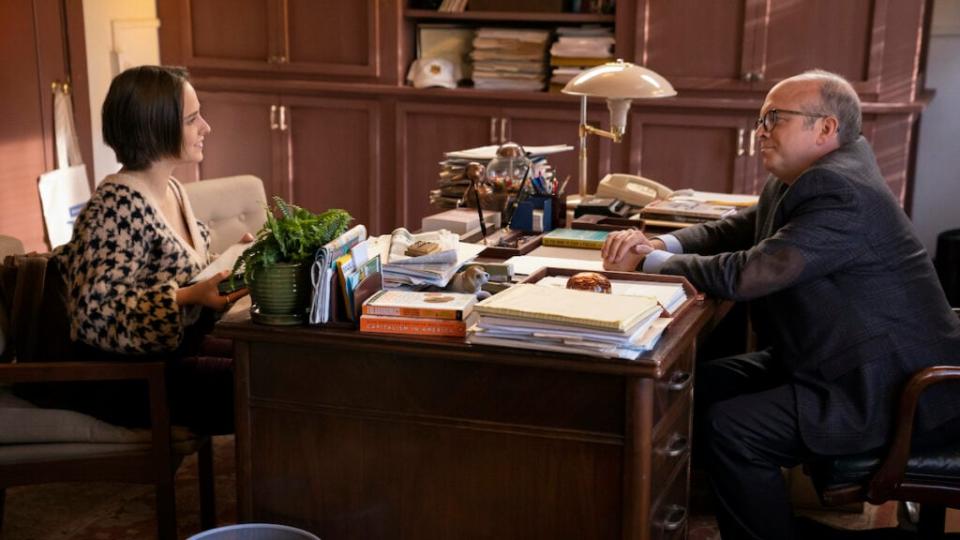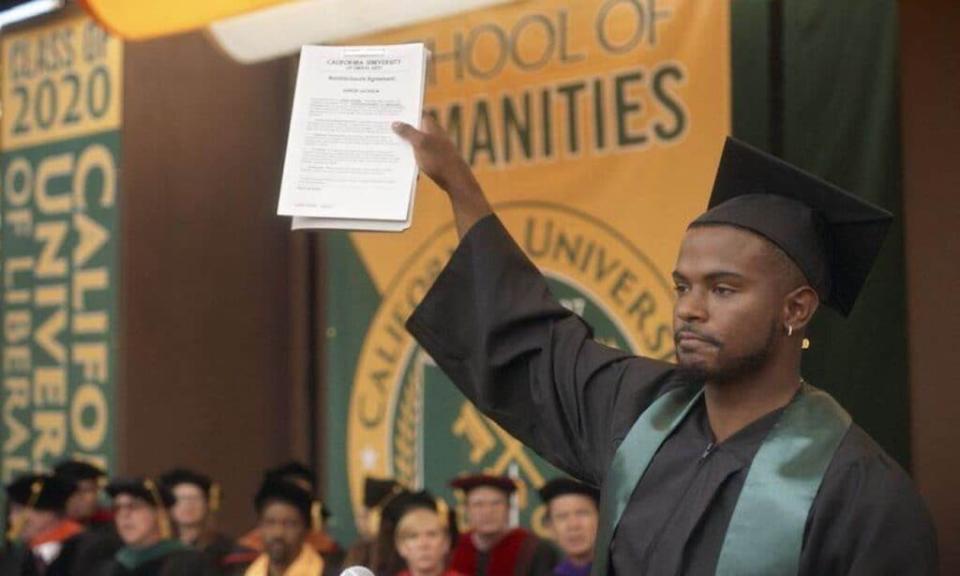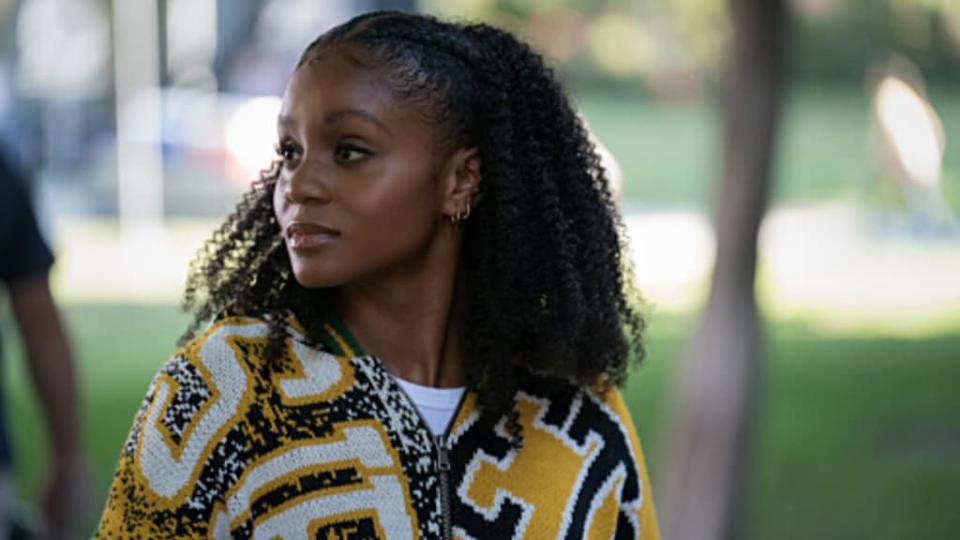How College-Set TV Shows Are Finally Portraying the Student Loan Debt Crisis
- Oops!Something went wrong.Please try again later.
- Oops!Something went wrong.Please try again later.
The national conversation around student loan debt has reached fever highs, yet college-set television shows have historically avoided including that reality of higher education in meaningful story lines. But there’s a growing amount of showrunners and writers who are trying to change that.
Right now, the clock is ticking as the moratorium on federal student loan repayments is set to expire on Dec. 31 after President Joe Biden moved to extend the executive order one final time while also forgiving up to $10,000 from borrowers who make less than $125,000 per year. The debt cancellation is just a drop in the ocean for the 43 million Americans who will need to begin making payments again in January — a daunting expense as inflation is expected to make way to a recession in the coming year.
So why do you seldom see the issue of student loan debt addressed among the college students and recent grads depicted in scores of TV and streaming shows?
According to several top writers and producers on shows like Freeform’s “Grown-ish,” The CW’s “All American” and HBO Max’s “The Sex Lives of College Girls,” there are special challenges to depicting socioeconomic issues in shows that tend to focus more on the personal and romantic exploits of its college-age characters. They’re often told by network bosses that audiences don’t want to see these stories at all.
“It’s catastrophic, the amount of money that some of these people have to promise to these financial institutions just so that they can start their lives off on even footing with some of their peers,” Justin Noble, co-creator of HBO Max’s “The Sex Lives of College Girls,” told TheWrap. His is one of few shows (past or current) that are centered around the college experience.
Also Read:
‘The Sex Lives of College Girls’ Renewed for Season 2 at HBO Max
“We did a lot of research and we actually went to a couple schools and talked with students to see what issues they were actually dealing with,” Noble said. “One of the things that kept coming up in our meetings with current college students was the sometimes extreme socioeconomic disconnects between people who were randomly assigned to live together and how awkward that can be when two people are splitting the cost of a couch but one of them has an egregious amount of money at their disposal and the other is struggling to make ends meet and putting themselves in debt and having to work just to pay to be in the school.”
It’s also personal for Noble. He’s also still paying off his own student loan debt, which he said added to his desire to put such stories on television. “It was something that I had experienced and felt like I would be able to dramatize accordingly,” he said.
It isn’t as if student loans have never been mentioned on the small screen, but rarely does a TV show explore the real consequences of agreeing to take on tens or hundreds of thousands of dollars in debt before even entering the workforce.
Noble’s series has chosen to tread into those waters, alongside The CW’s “All American” and Freeform’s “Grown-ish.” The trio of shows have each tackled student loan debt in their own ways, some more pervasive than others. For a show like “The Sex Lives of College Girls,” the socioeconomic disparities of the characters are engrained in the plot of the show. “Grown-ish” dedicated a whole episode to the topic of student loans, but it isn’t something that’s explored throughout an entire season. “All American” falls somewhere in the middle.

“Sex Lives” follows four girls from differing socioeconomic backgrounds at an elite private university. The series addresses the students’ finances in several ways, but no more bluntly than when Kimberly (Pauline Chalamet) loses her scholarship and work study job after involving herself in a cheating scandal — the ramifications of which are to be explored in Season 2.
The writers could have Kimberly take out some loans to continue her education. But Noble understands the weight of such a decision and explained that the writers wouldn’t do so without also exploring how that type of debt could cripple an 18-year-old who doesn’t come from an affluent background.
“It’s a lot for a college student to have to bite by themselves,” he said. “These are 18- and 19-year-old kids. We so easily forget that sometimes, but like two years ago, they were begging their parents to pick them up at an AMC theater. Now, they have to figure out their financial situation to stay at a school to provide for their own future. Maturity is forced upon them so quickly.”
Also Read:
How the Sports Film ‘Miracle’ Inspired Director Gillian Jacobs’ Disney+ Doc ‘More Than Robots’
The producers behind “Grown-ish” and “All American” have also made a conscious decision to not only to depict the college experience, but to make their characters’ socioeconomic challenges part of the story.
Des Moran, a writer on “Grown-ish,” told TheWrap that he saw the perfect opportunity to explore the student debt crisis during a Season 3 episode in which Aaron (Trevor Jackson) learns just how much debt he’s incurred. Despite his best efforts, Aaron can’t land a post-graduation job with a loan forgiveness program. Instead, he takes an offer as a teaching assistant at Cal U that will allow him to take classes toward a master’s degree for free and put off paying his debt a little bit longer.
“When I was going to college, when I was getting these loans constantly, I didn’t have an understanding of the effect that that was going to have on my future,” Moran said. “It wasn’t really explained to me either. I come from a very working-class family and background, and I was one of the first people in my family to go to college. So going to college for me felt like such a win, and it wasn’t really until I was a few months away from graduating when I had to go and have this meeting about starting to pay back my student loans six months after I graduated that I really realized like, ‘Oh, no, what have I done? I can barely pay rent, how am I going to pay this?’”
He added, “I think that’s a crisis that so many people have felt, and we just really had an opportunity with Aaron facing his senior year.”

The inclination to follow the characters of “All American” through their college experience — and even create an entire spin-off show with “All American: Homecoming” — was similar for showrunner Nkechi Okoro Carroll. The students in both of Carroll’s shows worked hard to be able to attend their institutions, securing athletic scholarships and other financial means. They’re constantly aware of what it might mean to lose access to that money.
“Talk to a good portion of college graduates today, and they’re talking about how much debt they’re still paying off into their 40s,” Carroll said. “That’s crazy to think that four years that you spent between 18 and 22, you’re still paying for in your 40s. It’s not free money. It’s real in that these are things that students are worried about… For me, it feels like this generation is much more aware of the fallout to all that student loan money than maybe we were when I was in college. That’s something we wanted to bring into the conversation and bring into the zeitgeist.”
And it’s not just a matter of rich kids versus poor kids. There are layers to who needs loans to pay for college. While some of the characters in “All American” come from low-income backgrounds, others have parents with the financial means to support them but are choosing not to do so. Exploring all of these nuances was especially important for Carroll, who added that the story often gets “oversimplified” for people of color.

In the series premiere of “Homecoming,” Simone (Geffri Maya) finds out that her parents refuse to pay for her housing, since she’s chosen to attend an HBCU over an Ivy League. Even though her tuition is still covered, Simone is candid about the fact that she can’t afford her housing without financial assistance. Student loans aren’t entirely off the table, but, as with “Sex Lives,” the characters are much more aware of how that could impact them in the future.
“There’s a school of thought out there that the stakes diminish a little bit in college. I would argue that is very much not the case and especially for kids in the Black community who are often perceived at a disadvantage — inaccurately so — but perceived at a disadvantage whether they need financial aid help or whatever it is to get into college or they’re on athletic scholarship,” Carroll said. “Those college years are pivotal to making or breaking their futures. There was never any thought to skip it out of those years. These are gonna be some of the best, most exciting stories we tell.”
It’s not just about whether or not the issue is important, though. There’s also the question of whether or not audiences want to watch stories like that on TV. According to Tom Nunan, former NBC Studios and UPN president, networks don’t believe that these types of stories are the most desirable ones to tell.
“A lot of people are turning to streaming and cable to escape,” he explained, noting that serious issues facing college students can be off-putting, especially to younger audiences seeking content that is more aspirational.
Also Read:
How the ‘Grown-ish’ Writers Room Navigates the Nuances of Gen Z Dating
“When ‘Friends’ was really at its peak [in] the first two seasons, where the numbers were just massive, the general age of those characters was in their mid-to-late 20s,” he continued. “Guess who the biggest demographic was for that show? 14-year-old girls. Not twentysomethings. Not late teens. [It was] young girls. So the college experience is interesting, because it’s like, who are [these shows] going to be appealing to?”
Of course, the showrunners who have succeeded at getting those stories on the small screen are bound to disagree. In their minds, helping just a few people feel seen is more than enough validation.
“It’s less stakes on paper, but the thing that never rang true to me about that is that stakes, in my mind as a writer, are only relative to the character that’s feeling them,” Noble said. “And a college student who’s 18 and has their entire life uprooted and moved to a new place, and they think that every decision they make is directly impacting the entirety of their future. They feel stakes at 100. So the stakes are huge for them. And if the stakes are huge for a character, they’ll feel huge for an audience.”
He also hopes that someone might find solace in those story lines. They may not be losing their scholarship due to a cheating scandal like Kimberly, but they might “find themselves in a financial situation that they need to address.”
“It kind of feels like a roadmap for people out there who might be dealing with similar things,” he said.
This article was updated on Friday, Aug. 26 to update latest developments in student loan forgiveness plans.

